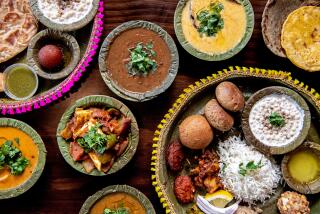Poet’s Stew
- Share via
Dishes with lyrical names tend to be flowers of a summer (to use a poetic expression for “short-lived”), but one poetic fancy has survived for at least 1,000 years in Asia. At Indian restaurants, you sometimes find a dish called nargisi kofta, which is the sort of thing the English call a Scotch egg: a hard-boiled egg encased in meat paste, then fried.
The “nargisi” part comes from the familiar Greek word “narcissus.” The narcissus we know best in this country is the daffodil, but the one referred to here is the highly perfumed N. poeticus, or poet’s narcissus. In place of the trumpet-like structure of the daffodil, it has a slightly raised ring with a wavy red edge, making the center of the blossom look a bit like an eye. A poet’s sweetheart’s eye, needless to say--in a Persian love poem, you’ve scarcely given your customers their money’s worth unless you’ve mentioned a languorous narcissus or two.
A thousand years ago, Baghdad chefs played off the appearance of this poetical flower, with its yellow center and white petals, by breaking eggs onto a stew and calling it narjisiyya. In the next three or four centuries, the idea was developed more subtly in Syria and Iraq by making a lattice of egg white on the stew and spotting whole yolks on top of that. In Spain and Morocco, cooks took the idea in another direction by pouring beaten eggs onto a stew and cooking them until they set, then cutting the egg layer into narcissus flower shapes.
Narjisiyya appears to have died out in the Arab world (and in later medieval recipes, the eggs actually became optional), but in Iran there are still vegetable stews called nargesi which are topped with eggs, and the egg-eye-flower theme survives in India--where, by the way, people are perfectly aware of the romantic symbolism of nargisi kofta.

